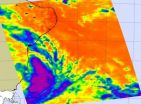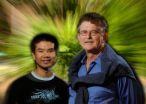(Press-News.org) TEMPE, Ariz – People with diabetes could be helped by a new type of self-monitoring blood glucose sensor being developed by Arizona State University engineers and clinicians at Mayo Clinic in Arizona.
More than 23 million people in the United States have diabetes. The disease is the fifth leading cause of death in the United States. It contributes to a higher risk for heart disease, blindness, kidney failure, lower extremity amputations and other chronic conditions.
Many people with diabetes suffer due to the difficulty of managing their blood glucose levels. It's recommended that they monitor their own glucose levels, but current monitoring devices typically require patients to perform the painful task of pricking their finger to draw blood for a test sample – and many patients must do it several times each day.
The new sensor would enable people to draw tear fluid from their eyes to get a glucose-level test sample.
Glucose in tear fluid may give an indication of glucose levels in the blood as accurately as a test using a blood sample, the researchers say.
"The problem with current self-monitoring blood glucose technologies is not so much the sensor. It's the painful finger prick that makes people reluctant to perform the test. This new technology might encourage patients to check their blood sugars more often, which could lead to better control of their diabetes by a simple touch to the eye," says bioengineer Jeffrey T. LaBelle.
LaBelle, the designer of the device technology, is a research professor in the School of Biological and Health Systems Engineering, one of ASU's Ira A. Fulton Schools of Engineering.
He is leading the ASU-Mayo research team along with Mayo Clinic physicians Curtiss B. Cook, an endocrinologist, and Dharmendra (Dave) Patel, chair of Mayo's Department of Surgical Ophthalmology.
The team reported on their early work on the sensor in the Journal of Diabetes Science and Technology last year and at various regional and national conferences.
Because of its potential impact on health care, the technology has drawn interest from BioAccel, an Arizona nonprofit that works to accelerate efforts to bring biomedical technologies to the marketplace.
"A critical element to commercialization is the validation of technology through proof-of -concept testing," says Nikki Corday, BioAccel business and development manager. "Positive results will help ensure that the data is available to help the research team clear the technical hurdles to commercialization."
Researchers must now compile the proper data set to allow for approval of human testing of the device.
"With funding provided by BioAccel, the research team will conduct critical experiments to determine how well the new device correlates with use of the current technology that uses blood sampling," says Ron King, BioAccel's chief scientific and business officer.
The results should help efforts to secure downstream funding for further development work from such sources as the National Institutes of Health and the Small Business Incentive Research Program, King says.
BioAccel will also provide assistance using a network of technical and business experts, including the New Venture Group, a business consulting team affiliated with the W. P. Carey School of Business at ASU under the supervision of associate professor Daniel Brooks.
The ASU-Mayo research team began the project with funds from a seed grant from Mayo Clinic. Researchers got assistance in the laboratory from ASU students involved in research at ASU's Biodesign Institute and the Ira A. Fulton Schools of Engineering Fulton Undergraduate Research Initiative program.
Team members assessed how current devices were working – or failing – and how others have attempted to solve monitoring problems, LaBelle says.
They came up with a device that can be dabbed in the corner of the eye, absorbing a small amount of tear fluid like a wick that can then be used to measure glucose.
The major challenges are performing the test quickly, efficiently, with reproducible results, without letting the test sample evaporate and without stimulating a stress response that causes people to rub their eyes intensely, LaBelle says.
A study commissioned by the American Diabetes Association reported that in 2007 the national economic burden related to diabetes was more than $170 billion – including about $116 billion in additional health care costs and $58 billion in lost productivity from workers debilitated by the disease.
###
SOURCES:
Jeffrey LaBelle, jeffrey.labelle@asu.edu
Assistant Research Professor
Harrington Bioengineering Program
School of Biological and Health Systems Engineering
Biodesign Institute at Arizona State University
(480) 727-9061
http://labs.biodesign.asu.edu/labelle/
Ron King, info@bioaccel.org
Chief Scientific and Business Officer
BioAccel
(602) 385-3212
MEDIA CONTACTS:
Joe Kullman, joe.kullman@asu.edu
Media Relations Officer
Ira A. Fulton Schools of Engineering
Arizona State University
(480) 965-8122 direct line
(480) 773-1364 mobile
http://engineering.asu.edu/
Lynn Closway, closway.lynn@mayo.edu
Mayo Clinic Public Affairs
(480) 301-4337
New device holds promise of making blood glucose testing easier for patients with diabetes
2011-03-16
ELSE PRESS RELEASES FROM THIS DATE:
NASA's Aqua Satellite spots rare Southern Atlantic sub-tropical storm
2011-03-16
NASA's Aqua satellite spotted some strong convection in a recently formed low pressure area that strengthened into Sub-Tropical Storm Arani in the South Atlantic. Arani formed near the coast of Brazil and is now moving away from it. Tropical cyclones in the Atlantic are a rare occurrence and since 2004 there have only been three of them, Arani being the third.
On March 14, 2011 at 1553 UTC (11:53 a.m. EST) the Atmospheric Infrared Sounder (AIRS) instrument that flies aboard NASA's Aqua satellite captured an infrared image of Sub-Tropical Storm Arani moving away from the ...
Large Hadron Collider could be world's first time machine
2011-03-16
If the latest theory of Tom Weiler and Chui Man Ho is right, the Large Hadron Collider – the world's largest atom smasher that started regular operation last year – could be the first machine capable causing matter to travel backwards in time.
"Our theory is a long shot," admitted Weiler, who is a physics professor at Vanderbilt University, "but it doesn't violate any laws of physics or experimental constraints."
One of the major goals of the collider is to find the elusive Higgs boson: the particle that physicists invoke to explain why particles like protons, neutrons ...
Toygaroo.com Launches Nation's Largest 'Online Toy Rental Service'
2011-03-16
Toygaroo.com, an innovative new toy rental company, has launched its online service, which will help families save money and go green by not having to throw out their old toys.
Toygaroo, which has a similar format to Netflix, allows families to rent toys for their children and provide a steady rotation of high-quality toys that can grow along with them. In addition, Toygaroo will be featured on the March 25 season premiere of ABC's "Shark Tank," a show that allows entrepreneurs to pitch their business ideas to successful investors.
"Any family with children understands ...
Insulin-releasing switch discovered
2011-03-16
Johns Hopkins researchers believe they have uncovered the molecular switch for the secretion of insulin — the hormone that regulates blood sugar — providing for the first time an explanation of this process. In a report published online March 1 in Cell Metabolism, the researchers say the work solves a longtime mystery and may lead to better treatments for type 2 diabetes, the most common form of the disease.
"Before our discovery, the mechanism behind how exactly the insulin-producing beta cells in the islet of Langerhans of the pancreas fail in type 2 diabetes was incompletely ...
Poorly presented risk statistics could misinform health decisions
2011-03-16
Choosing the appropriate way to present risk statistics is key to helping people make well-informed decisions. A new Cochrane Systematic Review found that health professionals and consumers may change their perceptions when the same risks and risk reductions are presented using alternative statistical formats.
Risk statistics can be used persuasively to present health interventions in different lights. The different ways of expressing risk can prove confusing and there has been much debate about how to improve the communication of health statistics.
For example, you ...
PURE Life Experiences Leads a Radical Shift in the Travel Industry: 85% of Travel Operators Agree That "Experiences" Are 7 Times More Important Than "Price" in the Differentiation of Their Offering
2011-03-16
Experts in the travel industry are progressively turning towards Experiential Travel and Transformational Travel to stand out in a much too undifferentiated, fusional and standardised world. A recent survey created by PURE confirms this trend: travel experts provided insightful information on the new challenges that operators in the industry will soon be facing and on how it is going to be all about the "experience". For the complete report, visit http://ww.purelifeexperiences.com/pureinsights.pdf.
According to the survey, 96.5% of Experiential suppliers agree that authentic ...
Newer antimalarials more effective than quinine against severe malaria
2011-03-16
Quinine should no longer be the drug of choice for treating severe malaria, according to an updated systematic review by Cochrane researchers. It is now evident that the antimalarial drug artesunate, which is derived from herbs used in Chinese medicine, is more effective at preventing death in patients with severe malaria.
Severe malaria occurs when the disease affects the function of vital organs. It is associated with rarer cerebral malaria, which affects the brain and can lead to long-term disability. More than a million people die each year from severe malaria, the ...
Tests on century-old equipment show how far X-rays have come
2011-03-16
OAK BROOK, Ill. – Researchers recently tested first-generation x-ray equipment from 1896 and found that it produced radiation doses and exposure times that were vastly higher than those of today's systems, according a study published online and in the May print edition of Radiology.
"To my knowledge, nobody had ever done systematic measurements on this equipment, since by the time one had the tools, these systems had been replaced by more sophisticated ones," said the study's lead author, Gerrit J. Kemerink, Ph.D., from Maastricht University Medical Center in the Netherlands.
Wilhelm ...
Study: Multi-tasking on the street not a good idea for older people
2011-03-16
CHAMPAIGN, Ill. — Older adults may put themselves at risk by talking on cell phones while crossing the street, researchers report in a new study. The researchers found that adults aged 59 to 81 took significantly longer than college students to cross a simulated street while talking on a mobile phone, and their heightened cautiousness in initiating crossing did nothing to improve their safety. Older adults on cell phones also were more likely to fail to cross in the time allotted for the task.
The findings, from researchers at the University of Illinois, appear in the ...
New articles examine safety of airport security scanners
2011-03-16
OAK BROOK, Ill. – The Transportation Security Administration (TSA) has begun to use whole-body imaging scanners as a primary screening measure on travelers passing through airport security checkpoints. One type of scanner employs millimeter wave technology, which delivers no ionizing radiation. However, the second type of scanner currently deployed at airports uses backscatter X-rays that expose the individual being screened to very low levels of ionizing radiation. In the April issue of Radiology, two articles address the question of what potential long-term public health ...



